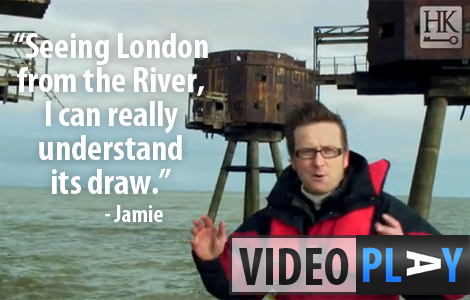London is under attack! But  don’t be alarmed, this is no April Fool: London’s always been under attack. For over two thousand years the city has been invaded, burnt, bridged and bombed. But while Boudicca, Caesar, Cnut and Hitler have been some of the city’s biggest enemies, today it’s the turn of climate change to have London scrambling her defences with the impressive Thames Barrier.
don’t be alarmed, this is no April Fool: London’s always been under attack. For over two thousand years the city has been invaded, burnt, bridged and bombed. But while Boudicca, Caesar, Cnut and Hitler have been some of the city’s biggest enemies, today it’s the turn of climate change to have London scrambling her defences with the impressive Thames Barrier.
Today the barrier’s iconic row of ‘sandals’ protect over a million Londoners from the perils of El Nio. But it’s just one of the places we visited as part of our defences tour down the Thames, a 12-hour trip from the edge of the North Sea to the heart of ancient London.
The Maunsell Sea Forts might just be the Second World War’s best-kept secret. Sprouting out of the Thames Estuary some six to 12 miles offshore, the extraterrestrial towers are among the city’s oddest sights. From 1942 until the end of the war men stationed on them shot down 22 German aircraft and over 30 doodlebug rockets, saving countless lives from the relentless terror of Blitzkrieg.
Today the forts’ future hangs in the balance, having been abandoned since the ’60s, when they were used as pirate radio stations. It’d be a tragedy to lose such a unique episode in British history, especially as the forts were pivotal in the making of modern oil rigs. You can help save the forts by visiting Project Redsand’s homepage.
But London was defended thousands of years before the Nazis rained down on its skies. Richborough, on the Kent coast, is largely thought to be the site of Emperor Claudius’s 43AD invasion, who galvanised his new frontier as he strode toward the Thames. Roman London would take until 200AD to get its own defensive wall, a full 140 years afterBoudicca tore through the city with her Celtic rebels. Today the wall still stands in fits and starts around the capital, though the only Celts to defend from nowadays are Rangers fans and Daniel O’ Donnell.
At the end of our trip stands one of London’s most iconic landmarks. Built almost a thousand years after the Roman wall, the Tower of London still looms fiercely over the river, its central White Tower a masterpiece of Norman architecture. But as William the Conqueror took hold of England following his famous victory at Hastings in 1066, he built the Tower to fend off his own people rather than outside aggressors.
“The castle, really, is a place where the military aristocracy can protect themselves,” says expert Eljas Oksanen. “It very much secured an iconic royal presence in this potentially rebellious Anglo-Saxon city.” Makes the massive queues to get in a little ironic, don’t you think?
HD Video: Episode 9 – London’s Defences
(Transcription of this video.)
Learn more about the bloody battles and defences of London with our other great Ancient World in London videos. Get involved in bloggers’ challenges, real-world events like our pub quiz or just learn more about the city’s ancient past. Heritage Key – Unlock the Wonders.